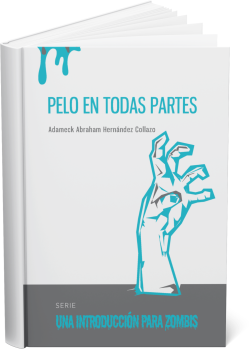Hair everywhere
Keywords:
Hair, Dermatology, Trichology, Skin, Medicine, HealthSynopsis
Throughout the following pages, Adameck presents us with his comprehensive proposal for understanding something that is ubiquitous in his field of expertise, dermatology: hair. He does so from a cultured and meticulous perspective, drawing on his vast knowledge and passion.
Hair everywhere is much more than a dermatologist talking about hair; it is an invitation to embark on a journey of knowledge and reflection through human anatomy and the anatomy of history, where hair is not just a pretext, but a necessary starting point because, as you will see by the end of this book, hair is everywhere.
Such is the liberating magic of this work, which invites us to journey through different stages of understanding hair. Individually and collectively, these stages form a single story, as they are part of a cycle. And what better way to immerse ourselves in the experience than in the company of Dr. Hernández Collazo, a physician, artist, and sensory being.
Anyone who begins reading this work is about to embark on a cyclical and dizzying experience that, through its 23 chapters, will take them through all the phases of hair for human knowledge: biological, scientific, intellectual, and sensory.
References
Allende, I. (1982). La casa de los espíritus. Plaza & Janés.
Angulo Daneri, T. (2009). Aicuña no es un pueblo de albinos. Letras Libres, (95), 38-46.
Antoniou, G., Bakopoulos, A. y Kanti, P. (2018). Black-hole solutions with scalar hair in Einstein-scalar-Gauss-Bonnet theories. Physical Review D, 97(8), 084037. https://doi.org/10.1103/PhysRevD.97.084037
Antunes, L., Bento, M. J., Sobrinho-Simões, M., Soares, P. y Boaventura, P. (2020). Cancer incidence after childhood irradiation for tinea capitis in a Portuguese cohort. The British journal of radiology, 93(1105). https://doi.org/10.1259/bjr.20180677
Basow, S. A. (1991). Women and Their Body Hair. Psychology of Women Quarterly, 15(1), 83-96. https://doi.org/10.1111/j.1471-6402.1991.tb00479.x
Basow, S. A. (1998). Women and Body Hair: Social Perception. Psychology of Women, 22(4), 637-645. https://doi.org/10.1111/j.1471-6402.1998.tb00182.x
Baum, P. F. (1922). Judas’s Red Hair. The Journal of English and Germanic Philology, 21(3), 520-529. http://www.jstor.org/stable/27702658
Bechah, Y., Capo, C., Mege, J. L. y Raoult, D. (2008). Epidemic typhus. The Lancet. Infectious diseases, 8(7), 417-426. https://doi.org/10.1016/S1473-3099(08)70150-6
Bellinger, W. (2007). Why African American women try to obtain “good hair”. Sociological Viewpoints, 23, 63-72.
Bogin, B. (2008). The dreadlocks treatise: On tantric hairstyles in Tibetan Buddhism. History of Religions, 48(2), 85-109. https://doi.org/10.1086/596567
Bom, S., Jorge, J., Ribeiro, H. M. y Marto, J. (2019). A step forward on sustainability in the cosmetics industry: A review. Journal of Cleaner Production, 225, 270-290. https://doi.org/10.1016/j.jclepro.2019.03.255
Bowles, D. (2018). They call me Güero: a border kid’s poem. Cinco Puntos Press.
Buffoli, B., Rinaldi, F., Labanca, M., Sorbellini, E., Trink, A., Guanziroli, E., Rezzani, R. y Rodella, L. F. (2013). The human hair: from anatomy to physiology. International Journal of Dermatology, 53(3), 331-341. https://doi.org/10.1111/ijd.12362
Cabrera Domínguez, N. B., Breto Rodríguez, A. G., Castro Márquez, M., Rosa Torres, M. y Milián Casanova, R. I. (2013). Piebaldismo en un recién nacido. Leucodermia rara. Revista de Ciencias Médicas de Pinar del Río, 17(1), 92-99.
Chandra, R. (2021). Serendipitous Medicines-Discoveries by Chance. International Journal of Composite and Constituent Materials, 7(2), 12-16.
Christensen, A. C. (2000). Cats as an aid to teaching genetics. Genetics, 155(3), 999-1004. https://doi.org/10.1093/genetics/155.3.999
Conti Díaz, I. A. y Mañé Garzón, F. (2008). Historia del favus (tiña fávica) en Uruguay y de la demostración de su naturaleza microbiológica. Revista Médica del Uruguay, 24(4), 277-281.
Courtois, M., Loussouarn, G., Hourseau, C. y Grolliier J. F. (1995). Ageing and hair cycles. British Journal of Dermatology, 132(1), 86-93. https://doi.org/10.1111/j.1365-2133.1995.tb08630.x
Crosta, M. C. (2020). Coat Color Genetics. En C. Noli y S. Colombo (eds.), Feline Dermatology (pp. 23-66). Springer.
De los Ríos Giraldo, A. L. (2016). Felicidad y economía: la felicidad como utilidad en la economía. Equidad y desarrollo, 1(26), 115-143. https://doi.org/10.19052/ed.3700
Derrett, J. D. M. (1973). Religious Hair. Man, 8(1), 100-103. https://doi.org/10.2307/2800614
Dyer, J. M. y Foy, V. M. (2022). Revealing The Unseen: A Review of Wood’s Lamp in Dermatology. The Journal of clinical and aesthetic dermatology, 15(6), 25-30.
Erbguth, F. (2008). From poison to remedy: the chequered history of botulinum toxin. Journal of Neural Transmission, 115, 559-565. https://doi.org/10.1007/s00702-007-0728-2
Falabella, R. (2009). Vitiligo and the melanocyte reservoir. Indian Journal of Dermatology, 54(4), 313-318. https://doi.org/10.4103/0019-5154.57604
Faulkner, W. (1976). Las palmeras salvajes (trad. J. L. Borges). Editorial Sudamericana.
Flanagan, N., Healy, E., Ray, A., Philips, S., Todd, C., Jackson, I. J., Birch-Machin, M. A. y Rees, J. L. (2000). Pleiotropic effects of the melanocortin 1 receptor (mc1r) gene on human pigmentation. Human molecular genetics, 9(17), 2531–2537. https://doi.org/10.1093/hmg/9.17.2531
Flores, R. y Telles, E. (2012). Social stratification in Mexico: disentangling color, ethnicity, and class. Am Sociol Rev, 77(3): 486-494. https://doi.org/10.1177/0003122412444720
Fölsing, A. (1998). Albert Einstein: A Biography. Physics Today, 51(1), 55. https://doi.org/10.1063/1.882100
Frey, A. S., McKee, M., King, R. A. y Martín, A. (2005). Hair Apparent: Rapunzel Syndrome. The American Journal of Psychiatry, 162(2), 242-248. https://doi.org/10.1176/appi.ajp.162.2.242
García Márquez, G. (1986). El amor en los tiempos del cólera. Cuadernos hispanoamericanos.
Ghanizadeh, A. (2014). A Review of Psychiatric Disorders Comorbidities in Patients with Alopecia Areata. International Journal of Trichology, 6(1), 2-4. https://doi.org/10.4103/0974-7753.136746
Ginsberg, B. A., Calderon, M., Seminara, N. M. y Day, D. (2016). A potential role for the dermatologist in the physical transformation of transgender people: A survey of attitudes and practices within the transgender community. Journal of the American Academy of Dermatology, 74(2), 303-308. https://doi.org/10.1016/j.jaad.2015.10.013
Glantz, M. (1984). De la amorosa inclinación a enredarse en cabellos. Ediciones Océano.
González Molina, J. (2001). Políticas de salud y vida saludable en México-Tenochtitlán. Promotion & Education, 8(2), 88-93. https://doi.org/10.1177/102538230100800216
Gunter, J. P. y Antrobus, S. D. (1997). Aesthetic Analysis of the Eyebrows. Plastic and Reconstructive Surgery, 99(7), 1808-1816. https://doi.org/10.1097/00006534-199706000-00002
Gupta, A. K. (2022). Minoxidil: a comprehensive review. Journal of Dermatological Treatment, 33(4), 1896-1906. https://doi.org/10.1080/09546634.2021.1945527
Herrera Romero, M. A. (2015). El mito de Medusa: Historia de una seducción. Alternativas en psicología, 18, 121-126.
Herzig, R. M. (2020). Plucked: A History of Hair Removal. New York University Press.
Jablonski, N. G. (2010). The naked truth. Scientific American, 302(2), 42-49. https://www.jstor.org/stable/26001896
Jablonski, N. G. (2019). A Natural History. University of California Press.
James, G. D. (2020). Allostasis and Adaptation: Biocultural Processes Integrating Lifestyle, Life History, and Blood Pressure Variation. American Anthropologist, 122(1), 51-64. https://doi.org/10.1111/aman.13366
Janssen Aguilar, R., Rochel Párez, A., Cuevas Koh, O. J., Santos Zaldivar, K. D., Rodríguez Cuevas, M., Inurreta Díaz, M. J. y Méndez Domínguez, N. I. (2020). Revisión sistemática del Síndrome de Rapunzel. Revista Biomédica, 31(1). https://doi.org/10.32776/revbiomed.v30i3.678
Journal of Photochemistry and Photobiology C: Photochemistry Reviews, 47. https://doi.org/10.1016/j.jphotochemrev.2021.100403
Kataria, S., Dabas, P., Saraswathy, K. N., Sachdeva, M. P. y Jain, S. (2022). Investigating the morphology and genetics of scalp and facial hair characteristics for phenotype prediction. Science & Justice, 62(1), 135-148. https://doi.org/10.1016/j.scijus.2022.12.002
Keynes, M. (2009). Letter to the Editor. Journal of Medical Biography, 17(1), 62-62. https://doi.org/10.1258/jmb.2007.007021
Kligman, A. M. y Ginsberg, D. (1950). Immunity of the adult scalp to infection with Microsporum audouinii. The Journal of investigative dermatology, 14(5), 345-358. https://doi.org/10.1038/jid.1950.43
Lane Furdell, E. (2007). Eponymous, anonymous: Queen Anne’s sign and the misnaming of a symptom. Journal of Medical Biography, 15(2), 97-101. https://doi.org/10.1258/j.jmb.2007.06-13
Li, A. Y. y Braun, V. (2017). Pubic hair and its removal: A practice beyond the personal. Feminism & Psychology, 27(3), 336-356. https://doi.org/10.1177/0959353516680233
MacDougall, J. P. (2003). Transnational Commodities as Local Cultural Icons: Barbie Dolls in Mexico. The Journal of Popular Culture, 37(2), 257-275. https://doi.org/10.1111/1540-5931.00067
Miyazawa, K. (1995). Evaluatuon of Haircare Products; Shampoo and Rinse. Journal of Society of Cosmetic Chemists of Japan, 29(2), 95-105. https://doi.org/10.5107/sccj.29.95
Monteiro de Assis, L. V., Tonolli, P. N., Moraes, M. N., Baptista, M. S. y Castrucci, A. M. L. (2021). How does the skin sense sun light? An integrative view of light sensing molecules.
Montero, R. (2013). La ridícula idea de no volver a verte. Seix Barral.
Nitka, M. (2020). “Everybody’s private carriage.” Omnibus Travel in Victorian Literature. Explorations; A Journal of Language and Literature, 8, 48-58. https://doi.org/10.25167/EXP13.20.8.5
Passos, M. R. L., Eleutério Jr., J., Bazzo, M. L., Carvalho, R. de S., Do Nascimento, A. G. y Oliveira Jr., M. da S. (2021). Syphilis, history, science, and arts: syphilis history calendar. Brazilian Journal of Sexually Transmitted Diseases, 33, 1-20. https://www.bjstd.org/revista/article/view/1136 https://doi.org/10.5327/DST-2177-8264-20213303
Peterson, R. K. (1995). Insects, disease, and military history: the Napoleonic campaigns and historical perception. American Entomologist, 41(3), 147-161. https://doi.org/10.1093/ae/41.3.147
Platón. (2003). Diálogos. Volumen IV: La República. Editorial Gredos.
Poe, E. A. (1860). Ligeia. En Historias extraordinarias (pp. 113-123). Imprenta de las novedades.
Popat, P. y Kotadia, K. (2013). Robert Louis Stevenson’s “Treasure Island” as an adventure novel. Asian Journal of Multidimensional Research, 2(6), 52-59.
Prokop, P. (2016). Male preference for female pubic hair: an evolutionary view. Anthropologischer Anzeiger, 73(2), 169-175. https://doi.org/10.1127/anthranz/2016/0583
Raoult, D., Woodward, T. y Dumler, J. S. (2004). The history of epidemic typhus. Infectious disease clinics of North America, 18(1), 127-140. https://doi.org/10.1016/S0891-5520(03)00093-X
Samrao, A., Chen, C., Zedek, D. y Price, V. H. (2010). Traction alopecia in a ballerina: clinicopathologic features. Arch Dermatol, 146(8), 918-935. https://doi.org/10.1001/archdermatol.2010.183
Sánchez, J. (2006). Los europeos ante una estética olfativa indoamericana. Tonos digital: revista electrónica de estsudios filológicos. (11).
Sankararaman, S., Mallick, S., Dannemann, M., Prüfer, K., Kelso, J., Pääbo, S., Patterson, N. y Reich, D. (2014). The genomic landscape of Neanderthal ancestry in present-day humans. Nature, 507, 354-357. https://doi.org/10.1038/nature12961
Scarano, M. A. (2005). Las huellas del Edipo en la elección de pareja. vitae, Academia Biomédica Digital, (23).
Schopenhauer, A. (2001). Aforismos sobre el arte de saber vivir. Editorial Debate.
Sherrow, V. (2023). Encyclopedia of hair: a cultural history. abc-clio. https://doi.org/10.5040/9781440880148
Shvarts, S. y Sadetzki, S. (2022). Ringworm and Irradiation: the historical, medical and legal implications of the forgotten epidemic. Oxford Academic. https://doi.org/10.1093/med/9780197568965.001.0001
Simbrón, H. P. (2012). La atracción en la elección de pareja. Revista científica de Ciencias de la Salud, 5(1), 55-60. https://doi.org/10.17162/rccs.v5i1.178
Solís, Y., García, M. y Palta, D. (2019). Reconocimiento de la cultura Afro en Bogotá: procesos comunicativos que se tejen alrededor de las estéticas del cabello de las mujeres negras del colectivo ‘Las Chontudas’ [Trabajo de grado, Corporación Universitaria Minuto de Dios]. https://repository.uniminuto.edu/handle/10656/10414
Suro Reyes, J. A. (2010). Alopecia por tracción: su ausencia en la mujer indígena mexican. Dermatología cosmética, médica y quirúrgica, 8(1). 13-16.
Synnott, A. (1987). Shame and Glory: A Sociology of Hair. The British Journal of Sociology, 38(3), 381-413. https://doi.org/10.2307/590695
Tarlo, E. (2019). Racial hair: the persistence and resistance of a category. Journal of the Royal Anthropological Institute, 25(2), 324-348. https://doi.org/10.1111/1467-9655.13028
Thomas, A., Varghese, S. A., Thomas, A., Jiju V. y Abraham, E. (2017). Hair is an accoutrement, hair is jewelry, it’s an accessory-Realize “The killing effects of shampoo”. Journal of Medicinal Plants Studies, 5(2), 238-242.
Tipples, J., Atkinson, A. P. y Young, A. W. (2002). The eyebrow frown: A salient social signal. Emotion, 2(3), 288-296. https://doi.org/10.1037/1528-3542.2.3.288
Trüeb, R. M., Rezende, H. D. y Dias, M. F. (2018). A Comment on the Science of Hair Aging. International Journal of Trichology, 10(6), 245-254. https://doi.org/10.4103/ijt.ijt_56_18
Vélez, A. (2020). Del big bang al Homo sapiens. Universidad de Antioquia.
Yesudian, P. (2011). Serendipity in trichology. International journal of trichology, 3(1), 1–2. https://doi.org/10.4103/0974-7753.82116

Downloads
Published
Series
Categories
License

This work is licensed under a Creative Commons Attribution-ShareAlike 4.0 International License.






